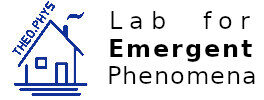Master thesis – Alexander Laska
Alexander Laska
Biquadric Fields: Equipping Finite Projective Spaces With “Metric” Structure
[PDF]
finished 2014-09
supervised by Klaus Mecke
Abstract
In order to practice physics within finite projective geometries — possibly an alternative to smooth manifolds as underlying spacetimes of physics — the notion of one quadric per point does not suffice to encode length in all directions and thus a pair of quadrics, a biquadric, has to be employed fro each point. This notion is an entirely new concept and not much is known about it. Hence the main scope of this master’s thesis had been to broaden the knowledge about this new notion. We found an explicitly parameterized matrix form of the embedding of an affine space into a projective space and vice versa, known as homogenization and dehomogenization, with respect to an arbitrary hyperplane at infinity. Additionally we found an explicitly parameterized matrix form of affine transformations represented be projectivities also with respect to an arbitrary hyperplane at infinity; both in arbitrary dimensions. Furthermore there are two main achievements of this master’s thesis that are grounded on these explicitly parameterized forms: the generalization of the explicitly parameterized form of the matrices underlying biquadrics from the specific center point p = (0, 0, 1) and the specific polar pol(p) = (0, 0, 1) in two dimensions to arbitrary center points and arbitrary polar hyperplanes in arbitrary dimensions. The coding of a library that enables one to calculate within finite projective geometries and first applications of it are the second achievement. Besides positive consistency checks we simulated random biquadric fields in the projective plane, found two different types of flat states (only within an affine plane and within the whole projective plane), and we produced a systematic list of all biquadrics in the projective plane of order 3.
In order to practice physics within finite projective geometries — possibly an alternative to smooth manifolds as underlying spacetimes of physics — the notion of one quadric per point does not suffice to encode length in all directions and thus a pair of quadrics, a biquadric, has to be employed fro each point. This notion is an entirely new concept and not much is known about it. Hence the main scope of this master’s thesis had been to broaden the knowledge about this new notion. We found an explicitly parameterized matrix form of the embedding of an affine space into a projective space and vice versa, known as homogenization and dehomogenization, with respect to an arbitrary hyperplane at infinity. Additionally we found an explicitly parameterized matrix form of affine transformations represented be projectivities also with respect to an arbitrary hyperplane at infinity; both in arbitrary dimensions. Furthermore there are two main achievements of this master’s thesis that are grounded on these explicitly parameterized forms: the generalization of the explicitly parameterized form of the matrices underlying biquadrics from the specific center point p = (0, 0, 1) and the specific polar pol(p) = (0, 0, 1) in two dimensions to arbitrary center points and arbitrary polar hyperplanes in arbitrary dimensions. The coding of a library that enables one to calculate within finite projective geometries and first applications of it are the second achievement. Besides positive consistency checks we simulated random biquadric fields in the projective plane, found two different types of flat states (only within an affine plane and within the whole projective plane), and we produced a systematic list of all biquadrics in the projective plane of order 3.
